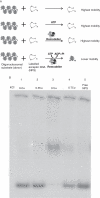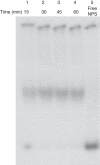Histone octamer trans-transfer: a signature mechanism of ATP-dependent chromatin remodelling unravelled in wheat nuclear extract
- PMID: 21896571
- PMCID: PMC3197459
- DOI: 10.1093/aob/mcr232
Histone octamer trans-transfer: a signature mechanism of ATP-dependent chromatin remodelling unravelled in wheat nuclear extract
Abstract
Background and scope: In eukaryotes, chromatin remodelling complexes are shown to be responsible for nucleosome mobility, leading to increased accessibility of DNA for DNA binding proteins. Although the existence of such complexes in plants has been surmised mainly at the genetic level from bioinformatics studies and analysis of mutants, the biochemical existence of such complexes has remained unexplored.
Methods: Histone H1-depleted donor chromatin was prepared by micrococcal nuclease digestion of wheat nuclei and fractionation by exclusion chromatography. Nuclear extract was partially purified by cellulose phosphate ion exchange chromatography. Histone octamer trans-transfer activity was analysed using the synthetic nucleosome positioning sequence in the absence and presence of ATP and its analogues. ATPase activity was measured as (32)Pi released using liquid scintillation counting.
Key results: ATP-dependent histone octamer trans-transfer activity, partially purified from wheat nuclei using cellulose phosphate, showed ATP-dependent octamer displacement in trans from the H1-depleted native donor chromatin of wheat to the labelled synthetic nucleosome positioning sequence. It also showed nucleosome-dependent ATPase activity. Substitution of ATP by ATP analogues, namely ATPγS, AMP-PNP and ADP abolished the octamer trans-transfer, indicating the requirement of ATP hydrolysis for this activity.
Conclusions: ATP-dependent histone octamer transfer in trans is a recognized activity of chromatin remodelling complexes required for chromatin structure dynamics in non-plant species. Our results suggested that wheat nuclei also possess a typical chromatin remodelling activity, similar to that in other eukaryotes. This is the first report on chromatin remodelling activity in vitro from plants.
Figures








Similar articles
-
Distortion of histone octamer core promotes nucleosome mobilization by a chromatin remodeler.Science. 2017 Jan 20;355(6322):eaaa3761. doi: 10.1126/science.aaa3761. Science. 2017. PMID: 28104838 Free PMC article.
-
Chromatin deacetylation by an ATP-dependent nucleosome remodelling complex.Nature. 1998 Oct 29;395(6705):917-21. doi: 10.1038/27699. Nature. 1998. PMID: 9804427
-
Mechanisms for ATP-dependent chromatin remodelling: farewell to the tuna-can octamer?Curr Opin Genet Dev. 2004 Apr;14(2):165-73. doi: 10.1016/j.gde.2004.01.007. Curr Opin Genet Dev. 2004. PMID: 15196463 Review.
-
Nucleosome movement by CHRAC and ISWI without disruption or trans-displacement of the histone octamer.Cell. 1999 Jun 25;97(7):843-52. doi: 10.1016/s0092-8674(00)80797-7. Cell. 1999. PMID: 10399913
-
Mechanisms for ATP-dependent chromatin remodelling: the means to the end.FEBS J. 2011 Oct;278(19):3579-95. doi: 10.1111/j.1742-4658.2011.08281.x. Epub 2011 Sep 8. FEBS J. 2011. PMID: 21810178 Free PMC article. Review.
Cited by
-
Insights into the regenerative property of plant cells and their receptivity to transgenesis: wheat as a research case study.Plant Signal Behav. 2012 Dec;7(12):1608-20. doi: 10.4161/psb.22424. Epub 2012 Oct 16. Plant Signal Behav. 2012. PMID: 23072995 Free PMC article. Review.
-
Epigenetics of wheat-rust interaction: an update.Planta. 2022 Jan 27;255(2):50. doi: 10.1007/s00425-022-03829-y. Planta. 2022. PMID: 35084577 Review.
-
SWI/SNF Chromatin Remodelers: Structural, Functional and Mechanistic Implications.Cell Biochem Biophys. 2023 Jun;81(2):167-187. doi: 10.1007/s12013-023-01140-5. Epub 2023 Apr 29. Cell Biochem Biophys. 2023. PMID: 37119511 Review.
References
Publication types
MeSH terms
Substances
LinkOut - more resources
Full Text Sources
Research Materials
Miscellaneous

